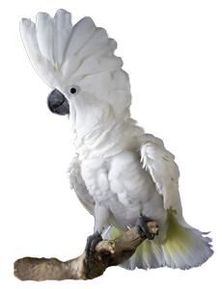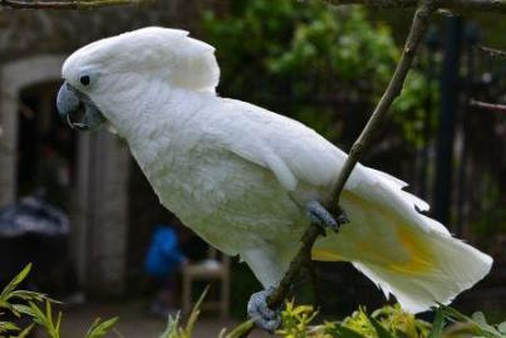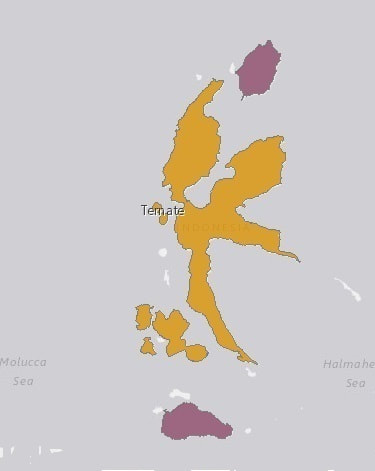Umbrella CockatooCacatua alba |

Custom Search
|
There is also an introduced breeding population in Taiwan. The umbrella Cockatoo inhabits primary and secondary forests, logged areas and open woodland, mangroves, and swamps but is most commonly found around the edge of clearings and rivers.
It's also found on agricultural land such as coconut plantations. They normally live below 900 m, spending most of their time in the trees canopies. The Umbrella Cockatoo is a medium-sized bird with a completely white plumage except for their underwings and the base of the tail which have distinct yellow colored patches. From all large cockatoo species, they are the only one with an all white crest. Usually, this crest sits flat on their head, but they will raise it if alarmed or fearful, excited or just curious. It's this semi-circular and umbrella-shaped head crest which gives them one of their common names, Umbrella cockatoo.

The umbrella cockatoo measures around 18 inches (46 cm) in length, and weighs anywhere from 14 oz (400 g) for the smaller females and up to 28 oz (800 g) for the bigger males.
Like all parrot species, they have a large, curved and quite powerful dark gray or black beak. Normally males have broader heads and bigger beaks than those of females. They have dark gray legs with zygodactyl feet, meaning they have 2 toes facing backward and 2 facing forward. This feature enables them to stand on one foot while grasping objects with the other, for feeding and manipulation. Both sexes display a bluish ring around the eyes, but males have dark brown or black eyes while females and younglings have brown or reddish-brown eyes. Similar to other species the Umbrella Cockatoo feathers create a powder resembling talcum powder. These cockatoos are known by other common names such as White Cockatoo, Great-white Cockatoo or White-crested Cockatoo. Subspecies / Taxonomy / Etymology There are no subspecies currently recognized for the umbrella cockatoo. The species was first described in 1776 by Philipp Ludwig Statius Müller a German zoologist. The Malay name for these type of birds, "kakaktua", originated their common name cockatoo, and translates literally as "older sister." The species specific name "Alba" derives from the feminine form of the Latin word "albus" meaning "white". Diet / Feeding
The umbrella cockatoo diet in the wild includes a variety of seeds, berries, roots, nuts, and fruits, such as durian, papaya, rambutan, and langsat. Occasionally they will also eat insects, such as crickets and probably even small reptiles like skinks. Since these birds also feed on corn, they can do considerable damage to crops and are therefore regarded as pests by farmers. When nesting their diet might include insects and also insect larvae. In the wild, they usually use the top of large trees to feed, but will sometimes forage a bit lower to become much less conspicuous to predators. In captivity, they are fed with a mix containing seeds, nuts and also dried fruits and vegetables. They also need to eat lots of fresh vegetables, fruits and branches together with leaves for chewing and entertainment. Reproduction The umbrella cockatoo is a monogamous species, meaning when they form a mating pair, they will stay together for life. In the mating season, males will strut, extend their wings, ruffles their feathers, spreading the tail feathers while erecting the species characteristic head crest, as a courtship behavior trying to attract females. Initially, the female may ignore or avoid the male, but if he is accepted, they will approach each other and the pair may be seen preening the head or scratching around the tail of each other. These behaviors are meant to strengthen the pair bond. Already bonded pairs have a much shorter courtship ritual and sometimes is the female who approaches the male. While usually, they live in small groups, once a pair is ready for nesting they will separate from their group and search for suitable nesting sites. Like other cockatoo species, the umbrella cockatoo builds its nests in hollows of large and tall trees. The female lays up to 3 white eggs in a single clutch, usually 2, these are incubated for about 30 days by both the female and male. When the eggs hatch the chicks are born altricial. This means they have their eyes closed and are born without feathers and mostly immobile, and rely on their parents for survival. Males and females will both help taking care of their offspring, but if more than 1 egg is laid, the first healthy chick to hatch is the one that will be cared for. Since the larger chick will become dominant over smaller chicks and therefore take most of the food, this makes sense. The chick learns to fly and leave the nest about 3 months after hatching but only become independent of their the parents around 15 to 18 weeks of age. Once this happens the group will rejoin the rest of the flock.These young cockatoos reach sexual maturity at about 3 to 4 years of age. Conservation status and major threats Due to several factors, the Umbrella Cockatoo population is in a rapid decline, and therefore it has been uplisted to Endangered by the IUCN. The main threat to the species is the capture for the illegal pet trade and habitat loss. Although these Cockatoos are listed in appendix II of the CITES list which restricts export and import of wild-caught birds however it's usual for catch quotas to be exceeded, in some places by up to 18 times. Even though in recent years fewer specimens have been collected from the wild it still faces unsustainable levels of exploitation. In some years trappers collect up to 17% of the wild Umbrella Cockatoo population, their illegal trade continues and is most probably grossly underestimated. Just like many other wildlife species they are also very affected by deforestation, usually for agriculture or mining.
|
Did You Know?
The voracious Nile monitor (Varanus niloticus) is the largest lizard species found in Africa . Scientific classification
Kingdom: Animalia Phylum: Chordata Class: Aves Order: Psittaciformes Family: Cacatuidae Genus: Cacatua Subgenus: Cacatua Species: C. alba |


